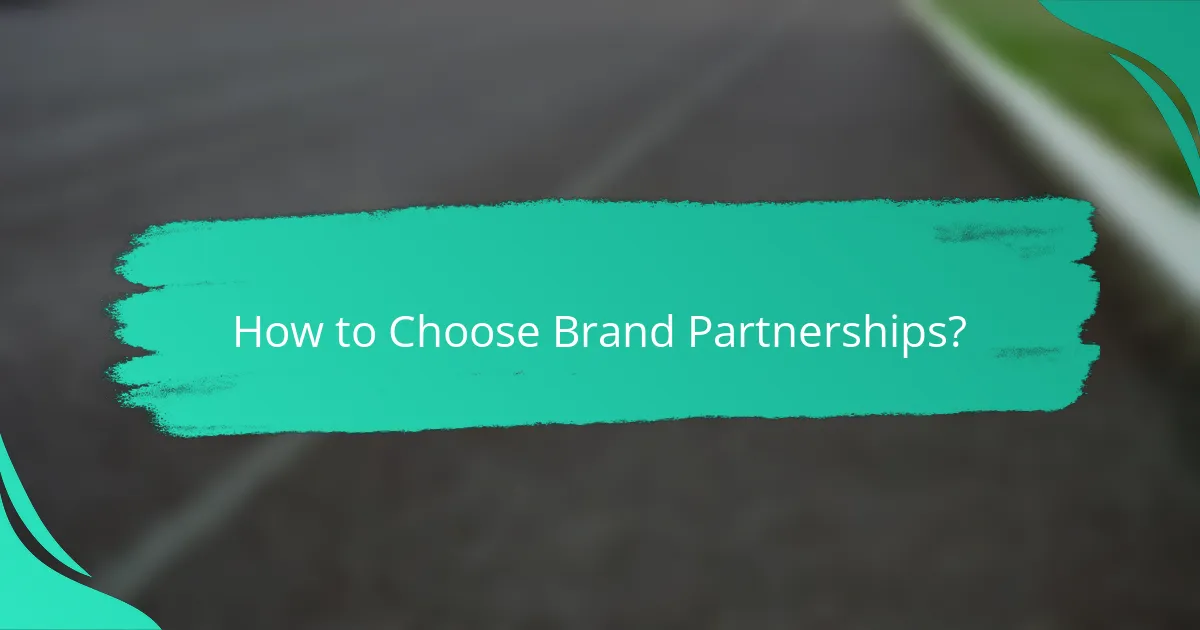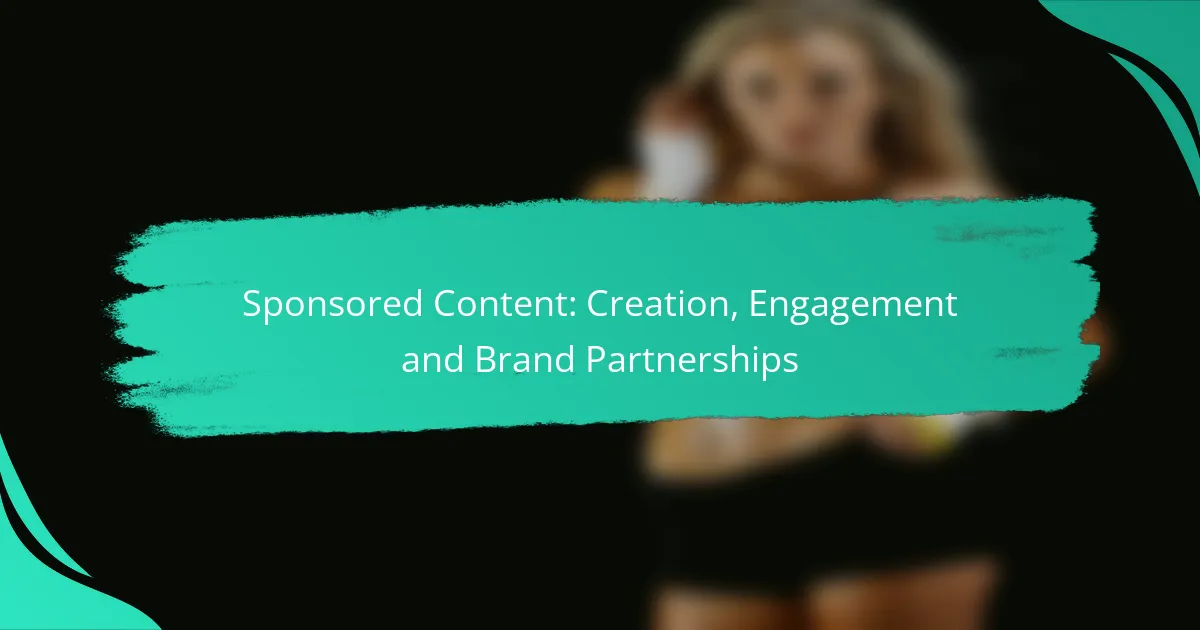Sponsored content is a powerful tool for brands looking to connect with their audiences through engaging storytelling and visual elements. By understanding their audience and implementing effective engagement strategies, brands can foster meaningful interactions that enhance loyalty and drive results. Strategic partnerships with like-minded brands further amplify these efforts, ensuring that collaborations resonate and deliver value to both parties.

How to Create Effective Sponsored Content?
Creating effective sponsored content involves understanding your audience, crafting engaging stories, and utilizing visual elements to enhance the message. By following best practices in SEO and measuring performance, brands can maximize the impact of their partnerships.
Define target audience
Identifying your target audience is crucial for creating relevant sponsored content. Consider demographics such as age, gender, location, and interests to tailor your message effectively. Use tools like surveys or analytics to gather insights about your audience’s preferences.
Once you have a clear profile, segment your audience into smaller groups to create personalized content that resonates with each segment. This approach increases engagement and fosters a stronger connection with your brand.
Craft compelling narratives
Compelling narratives are essential for capturing attention and driving engagement in sponsored content. Start with a strong hook that addresses the audience’s needs or interests, and build a story that aligns with your brand’s values.
Use relatable characters or scenarios to create an emotional connection. Incorporate storytelling techniques such as conflict and resolution to keep the audience invested. Aim for authenticity to foster trust and credibility with your audience.
Utilize visual elements
Visual elements enhance the effectiveness of sponsored content by making it more appealing and easier to digest. Incorporate high-quality images, infographics, and videos that complement your narrative and reinforce your message.
Ensure that visuals are relevant and support the content rather than distract from it. Use consistent branding in your visuals to strengthen brand recognition and create a cohesive experience across different platforms.
Incorporate SEO best practices
Integrating SEO best practices into your sponsored content helps improve visibility and reach. Start by conducting keyword research to identify relevant terms that your target audience is searching for. Use these keywords naturally throughout your content, including in headings and meta descriptions.
Optimize images with alt tags and ensure your content is mobile-friendly. Regularly update your content to keep it fresh and relevant, which can positively impact search engine rankings.
Measure performance metrics
Measuring performance metrics is vital for assessing the effectiveness of your sponsored content. Track key indicators such as engagement rates, click-through rates, and conversion rates to gauge success. Use analytics tools to gather data and insights on audience behavior.
Regularly review these metrics to identify trends and areas for improvement. Adjust your strategy based on findings to enhance future sponsored content and better meet your audience’s needs.

What Engagement Strategies Work Best?
Effective engagement strategies focus on fostering interaction and connection between brands and their audiences. Utilizing a mix of social media, user-generated content, interactive elements, and clear calls to action can significantly enhance audience involvement and brand loyalty.
Leverage social media platforms
Social media platforms like Facebook, Instagram, and Twitter are crucial for engaging audiences. Brands should tailor their content to fit the unique characteristics of each platform, using visuals and storytelling to capture attention. Regular posting and interaction with followers can create a vibrant community around the brand.
Consider using paid promotions to reach a broader audience, especially on platforms where organic reach is limited. Engaging with trending topics or hashtags can also increase visibility and encourage user interaction.
Encourage user-generated content
User-generated content (UGC) is a powerful way to engage audiences by allowing them to contribute their own experiences with the brand. This can include reviews, photos, or videos shared on social media. Brands can incentivize UGC through contests or campaigns that encourage customers to showcase their creativity.
Highlighting UGC on official channels not only builds community but also provides authentic content that resonates with potential customers. Brands should ensure they have clear guidelines for submissions to maintain quality and relevance.
Utilize interactive elements
Incorporating interactive elements such as polls, quizzes, and live Q&A sessions can significantly boost engagement. These features invite audiences to participate actively rather than passively consuming content. For example, a quiz related to a product can educate users while keeping them entertained.
Interactive content can also provide valuable insights into customer preferences and behaviors, allowing brands to tailor their strategies accordingly. Ensure that these elements are easy to access and share to maximize participation.
Implement call-to-action techniques
Effective call-to-action (CTA) techniques guide audiences toward desired actions, such as signing up for newsletters or making a purchase. CTAs should be clear, concise, and compelling, using action-oriented language to encourage immediate response. For instance, phrases like “Join now” or “Get your discount today” can create urgency.
Positioning CTAs strategically within content—such as at the end of blog posts or within social media posts—can enhance visibility. Testing different CTA styles and placements can help identify what resonates best with the audience, leading to higher conversion rates.

How to Choose Brand Partnerships?
Choosing brand partnerships involves aligning with brands that share similar values, understanding audience demographics, and defining clear partnership objectives. This strategic approach ensures that collaborations are mutually beneficial and resonate with target audiences.
Align with brand values
Successful brand partnerships hinge on shared values and missions. When brands align in their core beliefs, they create authentic collaborations that resonate with consumers. For example, a sustainable fashion brand partnering with an eco-friendly materials supplier can enhance their credibility and appeal.
To assess alignment, consider conducting a values audit. List out your brand’s core values and compare them with potential partners. Look for overlaps that can strengthen your message and enhance brand loyalty.
Evaluate audience overlap
Understanding audience overlap is crucial for effective brand partnerships. Analyze the demographics, interests, and behaviors of both brands’ audiences to identify common ground. This ensures that marketing efforts reach the right consumers, maximizing engagement and conversion rates.
Utilize tools like social media analytics and customer surveys to gather insights about your audience. Aim for at least a 50% overlap in target demographics to ensure that the partnership is relevant and impactful.
Assess partnership goals
Clearly defined partnership goals are essential for measuring success. Establish what each brand hopes to achieve, whether it’s increased brand awareness, sales growth, or enhanced customer engagement. Setting specific, measurable objectives will guide the partnership’s strategy and execution.
Consider creating a shared goals document that outlines key performance indicators (KPIs) for both parties. Regularly review these goals to adapt strategies as necessary and ensure both brands benefit from the collaboration.

What Are the Costs of Sponsored Content?
The costs of sponsored content can vary widely based on production, distribution, and influencer fees. Understanding these elements is crucial for budgeting effectively and maximizing the return on investment.
Determine production expenses
Production expenses include costs associated with creating the content itself, such as writing, design, and video production. Depending on the complexity, these costs can range from a few hundred to several thousand dollars.
Consider factors like the quality of the content, the expertise of the creators, and any necessary equipment or software. For instance, hiring a professional videographer will typically increase costs compared to using in-house resources.
Analyze distribution costs
Distribution costs refer to the expenses incurred when promoting the sponsored content across various platforms. This may include paid advertising on social media, search engine marketing, or partnerships with content distribution networks.
These costs can vary significantly based on the chosen platforms and target audience. For example, promoting content on Facebook may cost between $0.50 to $2.00 per click, while ads on LinkedIn can be higher, often exceeding $5.00 per click.
Consider influencer fees
Influencer fees are payments made to individuals who promote your sponsored content to their audience. These fees can vary based on the influencer’s reach, engagement rates, and niche.
Micro-influencers may charge anywhere from $100 to $1,000 per post, while larger influencers can demand thousands or even tens of thousands of dollars. It’s essential to evaluate the potential return on investment when selecting influencers for your campaign.

What Metrics Measure Sponsored Content Success?
To measure the success of sponsored content, focus on engagement rates and conversion rates. These metrics provide insights into how well the content resonates with the audience and its effectiveness in driving desired actions.
Track engagement rates
Engagement rates reflect how audiences interact with sponsored content, including likes, shares, comments, and time spent on the page. High engagement indicates that the content is capturing attention and encouraging interaction.
To effectively track engagement, use analytics tools to monitor metrics such as click-through rates (CTR) and social media interactions. Aim for CTRs in the range of 1-3% for effective campaigns, depending on the platform.
Consider segmenting your audience to understand which demographics engage more with your content. This can help tailor future campaigns to better suit your target market.
Analyze conversion rates
Conversion rates measure the percentage of users who take a desired action after interacting with sponsored content, such as signing up for a newsletter or making a purchase. A higher conversion rate indicates that the content effectively drives users towards specific goals.
To analyze conversion rates, set clear objectives for each campaign and track the number of conversions against the total number of visitors. A typical conversion rate for online content can range from 2-5%, but this varies by industry.
Utilize A/B testing to compare different versions of your content and identify which elements lead to higher conversions. Focus on optimizing calls to action (CTAs) and ensuring a seamless user experience to improve results.
